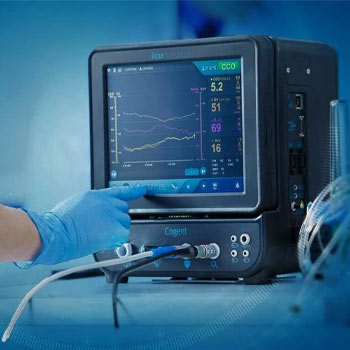Hemodynamic Monitoring
- Home
- Services
- Critical Care Medicine
- Hemodynamic Monitoring
What is Hemodynamic Monitoring?
Hemodynamic monitoring is a critical aspect of intensive care and critical care medicine, providing healthcare professionals with essential information about a patient's cardiovascular status. This monitoring involves the assessment and measurement of various parameters that reflect the function of the heart and blood vessels. Understanding hemodynamic monitoring is crucial for optimizing patient care in critical situations
What role does hemodynamic monitoring play in critical care?
In critical care settings, such as intensive care units (ICUs) and emergency departments, hemodynamic monitoring plays a pivotal role in assessing and managing patients with severe medical conditions. The primary goals of hemodynamic monitoring include
Assessment of Cardiac Function
Monitoring parameters such as cardiac output, stroke volume, and heart rate helps in evaluating the heart's ability to pump blood effectively
Optimization of Fluid Status
Monitoring intravascular volume and fluid responsiveness aids in determining the appropriate fluid therapy to maintain adequate tissue perfusion without fluid overload.
Early Detection of Hemodynamic Instability
Continuous monitoring allows for prompt identification of changes in cardiovascular status, facilitating timely intervention to prevent hemodynamic collapse
Guidance for Therapeutic Interventions
Hemodynamic data guides the selection and titration of vasoactive medications, such as vasopressors and inotropes, to support cardiovascular function.

What are the primary factors to consider in hemodynamic monitoring?
Hemodynamic monitoring involves measuring and interpreting several key factors
- Cardiac Output (CO): The volume of blood pumped by the heart per minute, reflecting cardiac performance
- Stroke Volume (SV): The volume of blood ejected from the heart with each contraction, indicating myocardial contractility
- Central Venous Pressure (CVP): The pressure in the vena cava near the right atrium, assessing right heart preload and fluid status
- Mean Arterial Pressure (MAP): The average pressure in the arteries during one cardiac cycle, reflecting tissue perfusion pressure
- Pulmonary Arterial Pressure (PAP): Pressure in the pulmonary artery, evaluating pulmonary circulation and right heart function
- Systemic Vascular Resistance (SVR): Resistance to blood flow in systemic circulation, influencing afterload on the heart
What are the different methods used for hemodynamic monitoring?
Several techniques are used for hemodynamic monitoring, including
Invasive Monitoring
Involves placing catheters directly into blood vessels (e.g., arterial lines, central venous catheters) to directly measure pressures and obtain blood samples
Non-invasive Monitoring
Utilizes external devices (e.g., echocardiography, pulse contour analysis) to estimate hemodynamic parameters without the need for invasive procedures
Clinical Applications and Challenges
In clinical practice, hemodynamic monitoring is integral to managing critically ill patients with conditions such as sepsis, acute respiratory distress syndrome (ARDS), and cardiogenic shock. However, challenges such as interpretation of data, complications related to invasive procedures, and variability in patient response to therapies underscore the importance of skilled healthcare professionals in utilizing hemodynamic data effectively
hemodynamic monitoring is essential for assessing cardiovascular function, optimizing fluid status, and guiding therapeutic interventions in critical care settings. Understanding the principles, parameters, and methods of hemodynamic monitoring is crucial for healthcare providers involved in the management of critically ill patients, ensuring timely and appropriate care to improve patient outcomes
For more information on hemodynamic monitoring and its applications in critical care, contact us today. Our team of experts is dedicated to providing comprehensive insights into advanced critical care practices
